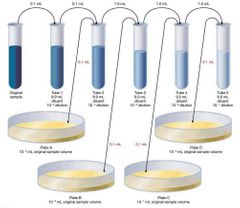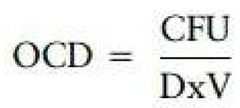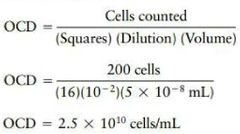![]()
![]()
![]()
Use LEFT and RIGHT arrow keys to navigate between flashcards;
Use UP and DOWN arrow keys to flip the card;
H to show hint;
A reads text to speech;
14 Cards in this Set
- Front
- Back
|
Standard Plate Count Visual |

|
|
|
Standard Plate Count Visual Explained |
The dilution assigned to each tube (written below the tube) represents the proportion of original sample inside that tube. Ex: If the dilution is 10^-4 , the proportion of original sample inside the tube would be 1/10,000th of the total volume inside. When 0.1 mL of that solution is transferred to a plate, the volume of sample in the plate is 0.1 mL x 10^-4 = 10^-5 ml. |
|

|
OCD - Original Cell Density
CFU - Colony Forming Units
D - the dilution as written on the dilution tube from which the inoculum comes. V - the volume transferred ro the plate. |
|

|
V1 and D1 are the volume and dilution of the concentrated broth, respectively. V2 and D2 are the volume and dilution of the completed dilution. |
|
|
Undiluted samples are always expressed as 1. Therefore, to calculate the dilution of a 1mL sanlmple transferred to 9 mL of diluent, the permuted formula would be used as follows... |

|
|
|
Original Sample Volume Formula |

|
|
|
Ex: You counted 37 colonies on an inoculated a plate with 0.1mL of a 10^-5 dilution. Knowing that this plate now contains 10^-6 mL of original sample, calculation would be as follows. |

|
|
|
Serial Dilution |
A serial dilution is simply a series of controlled transfers down a line of dilution blanks (tubes containing a known volume of sterile diluent -water, saline, or buffer). |
|
|
Dilution Banks |
Tubes containing a known volume of sterile diluent- water, saline, or buffer. |
|
|
Direct Count (Petroff-Mausser) |
Microbial direct counts, like plate counts, cake a small portion of a sample and use the data gathered from it to calculate the overall population cell density. This is made possible, with a device called a Petroff-Hausser counting chamber. |
|
|
Petroff-Hausser Counting Chamber |
Like a microscope slide with a 0.02 (2/100) mm-deep chamber, or "well", in the center containing an etched grid. The grid is one square millimeter and consists of 25 large squares, each of which contains 16 small squares, making a total of 400 small squares. |
|
|
Standard formula for calculating original cell density in a direct count. |

OCD is determined by counting the cells found in a predetermined group of small squares and dividing by the number of squares counted multiplied by the dilution 1 and the volume of sample above one small square. |
|
|
200 cells from a sample with a dilution factor of 10^-2 were counted in 16 squares (remembering that the volume above a single small square is 5x10^-8 mL), the cell density in the original sample would be calculated as follows: |

|
|
|
One Drawback of Diect Count |
One drawback of this method is that living and dead cells are counted. |

